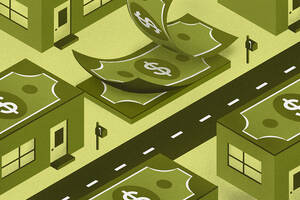Japan’s economy has been stuck in what economists call the “zero bound” since 1996. The zero bound is a danger zone where an economy’s short-term nominal interest rate is at or near zero percent. It can be a portal to an economic vortex that beckons massive unemployment and a deflationary spiral. The zero bound is also where the U.S. economy has been lodged since December 2008.
Economists argue heatedly over the best way to escape the zero bound’s danger vortex. An old idea that has been around since the Great Depression is that government spending can jolt a contracting economy with stuck interest rates back into the black. But Japan’s government has been spending to stimulate the economy since the mid-90s—and it has yet to achieve any significant growth—so what gives?
According to a recent paper by Sergio Rebelo, a professor of finance at the Kellogg School of Management, and his colleagues Lawrence Christiano and Martin Eichenbaum, both professors at Northwestern University, the power of government spending to stimulate an economy pinned against the zero bound is all in the timing.
A nimble government that spends quickly in the wake of a huge fiscal shock, while the economy is still stuck in the zero bound, can have a huge multiplier effect that brings the economy back to life. In this narrow window of time, the value of the government spending multiplier can be as large as 10 or even 20.
“In normal times, you would not want to use government spending to bring the economy out of a recession,” Rebelo says. “But when a zero-interest rate becomes binding, you can enter this strange economy, this peculiar world. It’s like quantum mechanics where things behave counter-intuitively. And in this strange economy, government spending can have a huge multiplier effect. Fiscal policy takes on a super power that it doesn’t have in normal times.”
Up Against the Zero Bound
Conventional wisdom says that when an economy experiences a shock and goes into a recession, the normal policy response is for the central bank to lower interest rates. We have seen this in the United States when all eyes turn to the Federal Reserve to shave off another quarter percentage point to help smooth out the ripples from past shocks. But if the shock is really big, the central bank can only cut interest rates so far.
“Of course, you can only lower the interest rate to zero,” Rebelo notes. “That is the limit on how much you can use conventional monetary policy to halt a recession.” So when monetary policy fizzles out, a big problem arises if the economy still has not gained steam and the zero-interest rate is binding. According to Rebelo, this is the point at which the economy becomes very strange and peculiar, and the point at which “government spending and fiscal policy can be incredibly powerful tools.” If done quickly enough, a speedy injection of government spending can break the zero-bound’s binding spell, squelch deflation, and stop a recessionary vortex in its tracks.
But Rebelo acknowledges that governments do not always move fast in the real world, and his team also acknowledges that many policymakers are often reticent to begin huge government spending programs because these programs can later be difficult to eliminate.
“When the U.S. put together an $800-billion fiscal package—the largest peace-time fiscal package ever—many economists were saying, ‘This is foolish, because when we increase government spending by one dollar, gross domestic product goes up by 80 cents or so, and we’ll have to raise taxes later to pay for the additional spending,’ ” Rebelo observes. The value of the government spending multiplier is typically small in the existing literature, he acknowledged, ranging from just below to just above one. “But what our paper shows is that in these very peculiar circumstances, you do actually want to increase government spending, and spend fast, because the multiplier effect can be quite large.”
A “Divine Coincidence”
The model Rebelo and his colleagues studied contains a “divine coincidence,” economist parlance for a lucky break of sorts, where the government multiplier is very large exactly when the zero bound is associated with a large recession. To reach this conclusion, Rebelo and his co-authors worked out a series of mathematical models. They started with a very simple model that can be worked out with just pen and paper. It reflects a rudimentary economy with no capital and no savings in which the central bank follows the Taylor Rule. This rule describes how central banks operate in many countries—by raising interest rates when inflation rises and lowering rates when unemployment worsens.
But in the second part of the paper they use a much more realistic model, which is similar to that used by central banks to simulate the effects of different policies. “We show in the second part that the same kinds of results we had in the simple model continue to be present in the more realistic model,” Rebelo says. “Once monetary policy has been used up, then fiscal policy can become very powerful.”
In the 1930s British economist John Maynard Keynes advanced the idea that economies behave strangely when they become trapped in the zero-bound, and that government spending could correct things. Many of Keynes’ ideas were put into practice until his theories fell out of favor in the late 1970s. But his ideas have enjoyed resurgence since 2007 when the global financial crisis forced many to re-examine the lessons from the Great Depression. Rebelo says that while a loose mathematical explanation for Keynes’ government spending fix was offered in the past, it is only recently that economists began to formalize his theories with complex working models.
Prior to working on this paper, Christiano, Eichenbaum, and Rebelo shared the conventional view that the government spending multiplier always has a small value. They were surprised at how big and effective the multiplier could be in certain circumstances, Rebelo admits.
“We changed our minds quite a bit while doing this research.”


